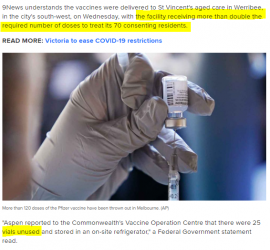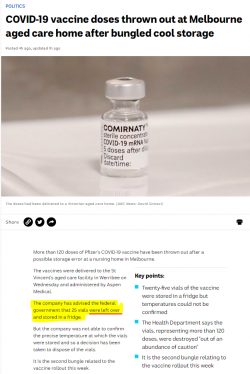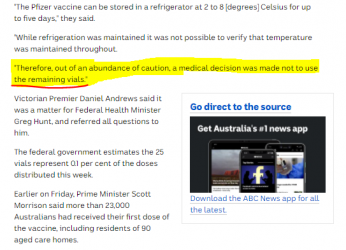No doubt, but this was avoidable and hopefully the contract between the Federal government and the company involved allows for some accountabilityOnce the vaccination schedule ramps up next month and supply improves with AZ, then such issues wont seem to be so newsworthy.
- Home
- Forums
- Community Announcements & Discussion
- Archive Forum
- Coronavirus (COVID-19)
- Vaccine & Treatments
You are using an out of date browser. It may not display this or other websites correctly.
You should upgrade or use an alternative browser.
You should upgrade or use an alternative browser.
The COVID-19 vaccine rollout in Australia has begun
- Thread starter Mattg
- Start date
-
- Tags
- covid-19 travel health
Lynda2475
Suspended
- Joined
- May 1, 2009
- Posts
- 9,395
- Qantas
- Platinum
- Virgin
- Red
- Oneworld
- Emerald
If there were open vaccines that couldn't be used at the facility, then a call for volunteers should have gone out to avoid wastage.
If they were stored incorrectly from get go then action should be taken against company responsible given how short the current supply is.
Given the special storage requirements for the Pfizer you'd think they bus the oldies to the hospital which has proper cold storage facilities to get their shot. Anyone who can't travel to hospital or too remote gets AZ which requires only an esky.
If they were stored incorrectly from get go then action should be taken against company responsible given how short the current supply is.
Given the special storage requirements for the Pfizer you'd think they bus the oldies to the hospital which has proper cold storage facilities to get their shot. Anyone who can't travel to hospital or too remote gets AZ which requires only an esky.
- Joined
- Nov 12, 2012
- Posts
- 29,025
- Qantas
- Platinum
- Virgin
- Platinum
- Star Alliance
- Gold
Disappointingly, more than 120 doses of Pfizer's COVID-19 vaccine have been wasted after a possible storage error at a nursing home in Melbourne.

COVID-19 vaccine doses thrown out at Melbourne aged care home
More than 120 doses of Pfizer's COVID-19 vaccine are thrown out after a possible storage error at nursing home in Melbourne.www.abc.net.au
No doubt, but this was avoidable and hopefully the contract between the Federal government and the company involved allows for some accountability
Not sure if we know it was avoidable. Possibly some no-shows or there was a delay in administrating the doses to the particular aged care facility, resulting in 20 or so vials being left at the end of the day. Only regular cold storage available, so they used that. Maybe there could have been a contingency of dry ice on hand and then rush to the nearest hospital with deep freeze capability. Or, as Lynda2475 said, round up volunteers ... although in the first week, I don't think the 'system could handle that!!
- Joined
- Jan 24, 2018
- Posts
- 8,777
- Qantas
- Gold
- Virgin
- Platinum
Might not have to worry soonIf there were open vaccines that couldn't be used at the facility, then a call for volunteers should have gone out to avoid wastage.
If they were stored incorrectly from get go then action should be taken against company responsible given how short the current supply is.
Given the special storage requirements for the Pfizer you'd think they bus the oldies to the hospital which has proper cold storage facilities to get their shot. Anyone who can't travel to hospital or too remote gets AZ which requires only an esky.

Australia considers approving Pfizer Covid vaccine for standard cold storage
Therapeutic Goods Administration may follow US in allowing vaccines to be stored at warmer temperatures
Lynda2475
Suspended
- Joined
- May 1, 2009
- Posts
- 9,395
- Qantas
- Platinum
- Virgin
- Red
- Oneworld
- Emerald
Or, as Lynda2475 said, round up volunteers ... although in the first week, I don't think the 'system could handle that!!
This was an entirely forseeable scenario given whats happemed in UK and USA and should have been planned for from week 1. There would be no shortage of volunteers.
lovetravellingoz
Enthusiast
- Joined
- Jul 13, 2006
- Posts
- 12,711
Volunteers are not relevant in this case as the problem was not lack of people to inject, but rather that the vials were stored in a refrigerator which did not have temperature monitoring.
Without the monitoring they do not know if the vials ever got out of the safe storage range. So while yes dry-ice can be used, if there is is no temperature monitoring it is useless too. Besides the problem here was not making sure the temperature was not monitored in a satisfactory way. By the time they realised the mistake it was too late and the vials thus deemed unusable
So the mistake was not continuous monitoring the temperature. ie Did the fridge get to warm overnight at any stage?
If you watch the footage of the vials being delivered throughout the world you will note that there is always a temperature monitoring device when they lift the lid sitting on top of the vials..
And while the vials were useless for anyone including volunteers in this case, the second point to consider is that this was an aged care facility, and not a hospital, or independent vaccination centre. They are only set up to handle people within the facility. Age care facilities do not want random strangers on site as it is too risky to the health of the residents, and health risk to residents are not just from CV19. For designated public sites like hospitals it is a different matter.
Without the monitoring they do not know if the vials ever got out of the safe storage range. So while yes dry-ice can be used, if there is is no temperature monitoring it is useless too. Besides the problem here was not making sure the temperature was not monitored in a satisfactory way. By the time they realised the mistake it was too late and the vials thus deemed unusable
"The Pfizer vaccine can be stored in a refrigerator at 2 to 8 [degrees] Celsius for up to five days," they said.
"While refrigeration was maintained it was not possible to verify that temperature was maintained throughout.
So the mistake was not continuous monitoring the temperature. ie Did the fridge get to warm overnight at any stage?
If you watch the footage of the vials being delivered throughout the world you will note that there is always a temperature monitoring device when they lift the lid sitting on top of the vials..
And while the vials were useless for anyone including volunteers in this case, the second point to consider is that this was an aged care facility, and not a hospital, or independent vaccination centre. They are only set up to handle people within the facility. Age care facilities do not want random strangers on site as it is too risky to the health of the residents, and health risk to residents are not just from CV19. For designated public sites like hospitals it is a different matter.
Last edited:
Lynda2475
Suspended
- Joined
- May 1, 2009
- Posts
- 9,395
- Qantas
- Platinum
- Virgin
- Red
- Oneworld
- Emerald
Volunteers are not relevant in this case as the problem was not lack of people to inject, but rather that the vials were stored in a refrigerator which did not have temperature monitoring.
According ABC News:
COVID-19 vaccine doses thrown out at Melbourne aged care home
More than 120 doses of Pfizer's COVID-19 vaccine are thrown out after a possible storage error at nursing home in Melbourne.
"The company has advised the federal government that 25 vials were left over and stored in a fridge." ... "Therefore, out of an abundance of caution, a medical decision was made not to use the remaining vials."
So it does not appear to be as you claim that none of the vials could be used, but that in fact some where used , but then the unused ones were then stored and as they could not verify that they had been stored at the right temperature had to be thrown out. IF they had adminstered more on the first day then 25 vials (up to 150 doses) were destroyed. This is very wasteful.
News.com (which is less reputable than ABC) also notes that there were extra unusedvials (and not the total supplied) - they actually claim the facility received double the doses they needed - so one has to ask rather to try and store the excess number, why didnt Aspen health contact someone to come and collect the excess delivery for deployment elsewhere?
Age care facilities do not want random strangers on site as it is too risky to the health of the residents, and health risk to residents are not just from CV19.
Firstly volunteers wouldnt be totally random walk ins, they would be pre-registered, subject to phone screening to make sure no symptoms and asked to come in. The vaccines are being adminstered by contract staff (not the aged care workers) who could give these in a room (office, meeting room, reception room) or even outdoor area (vernadah or carpark) away from residents after all residents have had their shots - this is what happens in the USA.
With no community cases atm, there are no restrictions on visiting Aged Care facilities at this time in most states, so if not directly intercating or crossing paths with at risk residents or their staff the risk is low.
Also vials can be transported in ice a short distance to another public building - townhall, medical centre, hospital provided doen before the limit of out of super cold storage is reached.
You just need to think sensibly and laterally.
Last edited:
People make mistakes. Every single day of their lives. Procedures are not perfect, in every part of our lives.
25 doses make up only 0.0001% of the total number of vaccines needed to immunise the whole country once. I am sure there's more wastage in the production process than that. They can learn from it and move on.
I am sure there are bigger medical issues and mistakes that happen on a daily basis throughout the country.
I really don't get this endless dissection, by the media, and in forums such as this, of every tiny little hiccup associated with COVID. Humans, as much as we want to be, a far from perfect. There are far bigger issues that warrant attention.
End of rant.
25 doses make up only 0.0001% of the total number of vaccines needed to immunise the whole country once. I am sure there's more wastage in the production process than that. They can learn from it and move on.
I am sure there are bigger medical issues and mistakes that happen on a daily basis throughout the country.
I really don't get this endless dissection, by the media, and in forums such as this, of every tiny little hiccup associated with COVID. Humans, as much as we want to be, a far from perfect. There are far bigger issues that warrant attention.
End of rant.
Lynda2475
Suspended
- Joined
- May 1, 2009
- Posts
- 9,395
- Qantas
- Platinum
- Virgin
- Red
- Oneworld
- Emerald
25 doses
25 vials = 150 doses (6 doses per vial). If News is correct that 25 vials is equal to double what was needed at that faqcility, then the wastage was 50% before you even count that its likley they may have only got 5 doses out of each of the other 25 vials that were used due to lack of the special syringes.
Several aged facilities did not receive their doses per schedule, this mistake meant 125-150 oldies and carers have missed out due to 3 compunded errors:
1. Disptach shipping double the ordered amount
2. Aspen not doing a count on recipt and notifying Feds of over supply such that they could have been collected and delivered elsewhere before spoiling;
3. Storing excess vials in fridge which couldnt be verified to meet requirments.
It might be a small amount of the total vaccine after we receive all doses, but right now its incredibly wasteful given limited amount available at present. And it is important these mistakes are dealt with or will continue to happen.
lovetravellingoz
Enthusiast
- Joined
- Jul 13, 2006
- Posts
- 12,711
Wow, that is not what was written in the article at all."The company has advised the federal government that 25 vials were left over and stored in a fridge." ... "Therefore, out of an abundance of caution, a medical decision was made not to use the remaining vials."
It is completing misleading to rewrite the article as "The company has advised the federal government that 25 vials were left over and stored in a fridge." ... "Therefore, out of an abundance of caution, a medical decision was made not to use the remaining vials."
- They were not thrown out because they were left over.
- They were not thrown out because they stored in a fridge.
- They were thrown out because they did not know, or not, if they had stayed cold enough.
What actually is the case is:
"But the company was not able to confirm the precise temperature at which the vials were stored and so a decision has been taken to dispose of the vials."
So vials not used within the first day CAN be left over and stored in a fridge for up to five days and then used within the next five days PROVIDED that they are also temperature monitored so that is guaranteed that they have not warmed up too much.
"The Pfizer vaccine can be stored in a refrigerator at 2 to 8 [degrees] Celsius for up to five days," they said.
"While refrigeration was maintained it was not possible to verify that temperature was maintained throughout.
"Therefore, out of an abundance of caution, a medical decision was made not to use the remaining vials.
If the vials had of been stored in a fridge with temperature monitoring they would have been used as long as they stayed within the required temperature range.
The issue here was not lack of people to inject, it was that without temperature monitoring that the vials were not known to have been safe to use.
HappyFlyerFamily
Senior Member
- Joined
- Feb 25, 2020
- Posts
- 5,136
Even if 25 vials (up to 150 doses) were disposed, I think its not a case of missing out, just a slight delay.
Total count theoretically delayed - about 160 (including the whole vial doses each given to 2 people)
Total count theoretically delayed - about 160 (including the whole vial doses each given to 2 people)
lovetravellingoz
Enthusiast
- Joined
- Jul 13, 2006
- Posts
- 12,711
People make mistakes. Every single day of their lives. Procedures are not perfect, in every part of our lives.
25 doses make up only 0.0001% of the total number of vaccines needed to immunise the whole country once. I am sure there's more wastage in the production process than that. They can learn from it and move on.
I am sure there are bigger medical issues and mistakes that happen on a daily basis throughout the country.
I really don't get this endless dissection, by the media, and in forums such as this, of every tiny little hiccup associated with COVID. Humans, as much as we want to be, a far from perfect. There are far bigger issues that warrant attention.
End of rant.
It is one very good reason to start slow. Beta testing if you will.
Whenever you role out any project there are going to be hiccups and mistakes. So you start off slow like we are doing, identify the bugs, and then ramp up.
One learning from today is they need to issue temperature mentoring gauges along with the vaccines if to a facility that just has standard fridges.
There are many staff in this process and a lot of training and then experience. There is not substitute to actually doing things to flush out the problems.
And as you basically have said perfection does not happen in life.
lovetravellingoz
Enthusiast
- Joined
- Jul 13, 2006
- Posts
- 12,711
Direct copy and paste from the article have highlighted for you, since you insist on calling me and ABC News a liar.
View attachment 242283
View attachment 242282
Again you misquote.
The ABC News was 100% accurate, your editing of their article was not.
I am not calling you a liar but to be blunt the pertinent part of the article seems to be beyond your grasp.
Can you really not comprehend that if the vials get out of the required temperature range that they are no longer safe to be used? And that is why they were not allowed to be used.
It is like the uncooked chicken in one's fridge. Perfectly safe to cook and eat the next day if it stays cold enough. But if the uncooked chicken gets too warm it is unsafe to later consume.
Australia's highest-earning Velocity Frequent Flyer credit card: Offer expires: 30 Apr 2025
- Earn 100,000 bonus Velocity Points
- Get unlimited Virgin Australia Lounge access
- Enjoy a complimentary return Virgin Australia domestic flight each year
- Earn 100,000 bonus Velocity Points
- Get unlimited Virgin Australia Lounge access
- Enjoy a complimentary return Virgin Australia domestic flight each year
AFF Supporters can remove this and all advertisements
Lynda2475
Suspended
- Joined
- May 1, 2009
- Posts
- 9,395
- Qantas
- Platinum
- Virgin
- Red
- Oneworld
- Emerald
And:

No one is disputing the main reason they were thrown out is because they werent stored properly, but it need never have gotten to the point of needing to be stored, because there shouldnt have been so many vials left over (too many delivered) and they could have been returned/redployed/offered to others if done so earlier and not tried storing them.

No one is disputing the main reason they were thrown out is because they werent stored properly, but it need never have gotten to the point of needing to be stored, because there shouldnt have been so many vials left over (too many delivered) and they could have been returned/redployed/offered to others if done so earlier and not tried storing them.
Lynda2475
Suspended
- Joined
- May 1, 2009
- Posts
- 9,395
- Qantas
- Platinum
- Virgin
- Red
- Oneworld
- Emerald
The ABC News was 100% accurate, your editing of their article was not.
I am not calling you a liar but to be blunt the pertinent part of the article seems to be beyond your grasp.
Can you really not comprehend that if the vials get out of the required temperature range that they are no longer safe to be used? And that is why they were not allowed to be used.
I didnt edit the article, i posted the full link and cut the two quotes which showed that they were ünused doses. I did not change a single word, the quotes were direct. Apparently its ok for you to post selected lines from an article but noone else - i posted the quotes that proved what you are implying that they werent left over is not correct.
Its not me failing to grasp anything, its you. Yes the incorrect storage resulted them in needing to be thrown out, but you are ignoring the fact it only got to that point because there were unused. They adminstered doses to 70 residents, then stored the remaining vials unreliably.
Had they notified the over delivery on Wednesday morning (delivery day), the poor over night storage wouldnt have seen them go to waste. They could have been used elsehwere on the same day or taken to somewhere where correct storage procedure could be followed.
drron
Veteran Member
- Joined
- Jul 4, 2002
- Posts
- 36,347
Or QLD,or NSW,or TAS,or WA and even SA.Why do all the issues (F@!K ups) seem to happen in MEL.
tgh
Established Member
- Joined
- Apr 23, 2006
- Posts
- 3,609
..bbbut really… wasting a few vials is trivial in the argy bargy of overall government wastage..
Ships/submarines/insulation/water/electricity…..…and on it goes...
I heard some feed back today about the aged care vaccination programme in Qld (where we are patiently waiting for vaccination of a 97yo)
Simply described as chaotic… couldn't arrange a fight in a Birdsville pub….
What else would we expect..
Ships/submarines/insulation/water/electricity…..…and on it goes...
I heard some feed back today about the aged care vaccination programme in Qld (where we are patiently waiting for vaccination of a 97yo)
Simply described as chaotic… couldn't arrange a fight in a Birdsville pub….
What else would we expect..
Or QLD,or NSW,or TAS,or WA and even SA.
So what you're really saying is NT and ACT are perfect!
Become an AFF member!
Join Australian Frequent Flyer (AFF) for free and unlock insider tips, exclusive deals, and global meetups with 65,000+ frequent flyers.AFF members can also access our Frequent Flyer Training courses, and upgrade to Fast-track your way to expert traveller status and unlock even more exclusive discounts!

AFF forum abbreviations
Wondering about Y, J or any of the other abbreviations used on our forum?Check out our guide to common AFF acronyms & abbreviations.
















